ConvNeXt-L-Based Recognition of Decorative Patterns in Historical Architecture: A Case Study of Macau
Abstract
1. Introduction
1.1. Research Background and Significance
1.2. Research Status and Problem Analysis
1.3. Research Objectives and Content
1.4. Literature Review
1.4.1. Current Research on Decorative Patterns in Macau’s Historical Architecture
1.4.2. Advances in the Intelligent Analysis and Real-Time Processing of Architectural Decoration Patterns
1.4.3. ConvNeXt Model and Its Application
2. Materials and Methods
2.1. Data Collection Scope and Target
2.2. Classification of Building Types and Sample Size
2.3. Image Cropping and Annotation
2.4. Image Preprocessing
2.5. Transfer Learning
3. Results
3.1. Experimental Design and Modeling Methods
3.1.1. ConvNeXt-L Model Construction
3.1.2. ConvNeXt-L Model Training
3.1.3. Dataset Partitioning and Training Process
3.2. Training Results
3.2.1. Evaluation Metrics for Classification Performance
- (1)
- Accuracy
- (2)
- Precision
- (3)
- Recall rate
- (4)
- F1-score
3.2.2. Overall Classification Results
3.3. Comparative Analysis of Model Performance
3.3.1. Overall Performance Comparison
3.3.2. Confusion Matrix
3.4. Grad-CAM Visualization Analysis
3.4.1. ConvNeXt-L Model
3.4.2. Analysis of Attention Region Characteristics in Grad-CAM Heatmaps Across Models and Building Categories
- (1)
- Analysis of Attention Regions in Grad-CAM Heatmaps.
- (2)
- Performance Characteristics of Different Model Architectures.
- (1)
- Pattern scale and structure.
- (2)
- Surface texture and material.
- (3)
- Grad CAM verification corresponds to cultural elements.
3.4.3. Quantitative Analysis of Grad-CAM Interpretability
4. Discussion
5. Conclusions
Author Contributions
Funding
Data Availability Statement
Acknowledgments
Conflicts of Interest
References
- Liang, S. History of Chinese Architecture; Guizhou People’s Publishing House: Guiyang, China, 2023. [Google Scholar]
- Lin, F. Stories of Macau Historic Architecture; Guangdong Economic Publishing House: Guangzhou, China, 2019. [Google Scholar]
- Guo, J. The application of traditional patterns in the decoration of Ming and Qing architecture. Art Stud. 2015, 31, 116–118. [Google Scholar]
- Zou, Q.; Cao, Y.; Li, Q.; Huang, C.; Wang, S. Chronological Classification of Ancient Paintings Using Appearance and Shape Features. Pattern Recognit. Lett. 2014, 49, 146–154. [Google Scholar] [CrossRef]
- Can, G.; Odobez, J.-M.; Gatica-Perez, D. How to Tell Ancient Signs Apart? Recognizing and Visualizing Maya Glyphs with CNNs. J. Comput. Cult. Herit. 2018, 11, 20. [Google Scholar] [CrossRef]
- Sajol, S.I.; Hasan, A.S.M.J.; Islam, S.; Rahman, S. A ConvNeXt V2 Approach to Document Image Analysis: Enhancing High-Accuracy Classification. In Proceedings of the 2024 IEEE 3rd Conference on Information Technology and Data Science (CITDS), Debrecen, Hungary, 26–28 August 2024; pp. 1–6. [Google Scholar] [CrossRef]
- Condoroici, R.G.; Florea, C.; Vertan, C. Automatically Classifying Paintings with Perceptually Inspired Descriptors. J. Vis. Commun. Image Represent. 2015, 26, 222–230. [Google Scholar] [CrossRef]
- Smith, A.; Johnson, B.; Lee, C. Automated Building Anomaly Detection and Degradation Prediction Using AI Models. Buildings 2023, 13, 2805. [Google Scholar] [CrossRef]
- Liu, X.; Chen, Z. Macau Architectural Cultural Heritage; Southeast University Press: Nanjing, China, 2005. [Google Scholar]
- Chen, Z.-C.; Long, F.-Z. Aomen Lishi Jianzhu Beiwang Lu (Yi) (Memorandum of Macau Historical Buildings. Part 1); Yi Chan Xue Hui: Macau, China, 2019. [Google Scholar]
- Da Silva, B.B. Chronicle of Macao («Macau Chronicle»); Macao Foundation: Macao, China, 2013. [Google Scholar]
- Gunn, G.C. History of Macao, 1557–1999; Hong Kong University Press: Hong Kong, China, 2010. [Google Scholar]
- Yin, M. Study on Decorative Forms of Macau Architecture under Multicultural Integration. Master’s Thesis, Nanjing Forestry University, Nanjing, China, 2013. [Google Scholar]
- She, M.; Li, M.; Liang, M. Study on the Characteristics of Garden Architecture and Decorative Pieces in Macau. Chin. Landsc. Archit. 2011, 27, 52–56. [Google Scholar]
- Feng, J. Research on Grey Sculpture Decoration of Macau Residential Buildings—Taking Lou Kau Mansion as an Example. In China Creative Design Yearbook 2020–2021; Macau University of Science and Technology, School of Humanities and Arts: Macau, 2022; pp. 28–34. [Google Scholar]
- Xiang, L. Application of Elements of Macau Historical Architecture in Jewelry. Shanghai Light Ind. 2023, 24–26. [Google Scholar]
- Chen, Y.; Zhao, F.; Wang, D. AI Model for Construction Waste Classification Using Data Augmentation. Buildings 2022, 12, 175. [Google Scholar] [CrossRef]
- Rawat, W.; Wang, Z. Deep Convolutional Neural Networks for Image Classification: A Comprehensive Review. Neural Comput. 2017, 29, 2352–2449. [Google Scholar] [CrossRef]
- Chaowalit, O.; Kuntitan, P. Using Deep Learning for the Image Recognition of Motifs on the Center of Sukhothai Ceramics. Curr. Appl. Sci. Technol. 2021, 21, 991–1004. [Google Scholar] [CrossRef]
- Yoshimura, Y.; Cai, B.; Wang, Z.; Ratti, C. Deep Learning Architect: Classification for Architectural Design through the Eye of Artificial Intelligence. arXiv 2019. [Google Scholar] [CrossRef]
- Llamas, J.; Lerones, P.M.; Medina, R.; Zalama, E.; Gómez-García-Bermejo, J. Classification of Architectural Heritage Images Using Deep Learning Techniques. Appl. Sci. 2017, 7, 992. [Google Scholar] [CrossRef]
- Obeso, A.M.; Vázquez, G.M.S.; Acosta, A.A.R.; Benois-Pineau, J. Connoisseur: Classification of Styles of Mexican Archi-tectural Heritage with Deep Learning and Visual Attention Prediction. In Proceedings of the 15th International Workshop on Content-Based Multimedia Indexing (CBMI), Florence, Italy, 19–21 June 2017; pp. 1–6. [Google Scholar]
- Lin, C. Application of Traditional Cultural Symbols in Art Design under the Background of Artificial Intelligence. Math. Probl. Eng. 2021, 1–11. [Google Scholar] [CrossRef]
- Chen, L.; Feng, J.; Lin, M.; Zhou, Y. Research on processing technology of Hainan Li brocade pattern elements based on MATLAB. Comput. Knowl. Technol. 2016, 12, 206–208. [Google Scholar] [CrossRef]
- Sun, M.; Zhang, D.; Ren, J.; Wang, Z.; Jin, J.S. Brushstroke based sparse hybrid convolutional neural networks for author classification of Chinese ink-wash paintings. In Proceedings of the 2015 IEEE International Conference on Image Processing (ICIP), Quebec City, QC, Canada, 27–30 September 2015; pp. 626–630. [Google Scholar] [CrossRef]
- Chu, W.-T.; Tsai, M.-H. Visual Pattern Discovery for Architecture Image Classification and Product Image Search. In Proceedings of the 2nd ACM International Conference on Multimedia Retrieval, Hong Kong, China, 5–8 June 2012; pp. 1–8. [Google Scholar]
- Ba, J.L.; Kiros, J.R.; Hinton, G.E. Layer Normalization. arXiv 2016, arXiv:1607.06450. [Google Scholar] [CrossRef]
- Ma, Y.; Xu, H.; Feng, Y.; Lin, Z.; Li, F.; Wu, X.; Liu, Q.; Zhang, S. MSDEnet: Multi-scale detail enhanced network based on human visual system for medical image segmentation. Comput. Biol. Med. 2024, 170, 108010. [Google Scholar] [CrossRef]
- Lu, W.; Hu, Y.; Peng, F.; Feng, Z.; Yang, Y. A Geoscience-Aware Network (GASlumNet) Combining UNet and ConvNeXt for Slum Mapping. Remote Sens. 2024, 16, 260. [Google Scholar] [CrossRef]
- Taha, H.; El-Habrouk, H.; Bekheet, W.; El-Naghi, S.; Torki, M. Pixel-Level Pavement Crack Segmentation Using UAV Remote Sensing Images Based on the ConvNeXt-UPerNet. Alex. Eng. J. 2025, 124, 147–169. [Google Scholar] [CrossRef]
- Lin, M.; Wu, J.; Meng, J.; Wang, W.; Wu, J. Screening of Retired Batteries with Gramian Angular Difference Fields and ConvNeXt. Eng. Appl. Artif. Intell. 2023, 123 Part B, 106397. [Google Scholar] [CrossRef]
- Qiao, Y.; Zhang, Q.; Qi, Y.; Wan, T.; Yang, L.; Yu, X. A Waste Classification Model in Low-Illumination Scenes Based on ConvNeXt. Resour. Conserv. Recycl. 2023, 199, 107274. [Google Scholar] [CrossRef]
- Chen, L.; Chen, J.; Zou, Q.; Huang, K.; Li, Q. Multi-View Feature Combination for Ancient Paintings Chronological Classifi-cation. J. Comput. Cult. Herit. 2017, 10, 7. [Google Scholar] [CrossRef]
- Todi, A.; Narula, N.; Sharma, M.; Gupta, U. ConvNext: A Contemporary Architecture for Convolutional Neural Networks for Image Classification. In Proceedings of the 2023 3rd International Conference on Innovative Sustainable Computational Technologies (CISCT), Dehradun, India, 8–9 September 2023; pp. 1–6. [Google Scholar]
- Ioffe, S. Batch Renormalization: Towards Reducing Minibatch Dependence in Batch-Normalized Models. Adv. Neural Inf. Process. Syst. 2017, 30, 1942–1950. [Google Scholar]
- Wu, L.Y. Poverty Level Classification Post-Rural Flooding Disasters Using Deep Neural Networks and Transfer Learn-ing. Earth Sci.-J. China Univ. Geosci. 2023, 48, 112–125. [Google Scholar]
- Li, X.Y.; Liu, X.; Chen, C. Image Retrieval Algorithm Based on Transfer Learning. Comput. Sci. 2019, 46, 73–77. [Google Scholar]
- Stock, P.; Cisse, M. ConvNets and ImageNet Beyond Accuracy: Understanding Mistakes and Uncovering Biases. In Proceedings of the European Conference on Computer Vision (ECCV), Munich, Germany, 8–14 September 2018; pp. 498–512. [Google Scholar]
- Zhang, Z.; Wen, Y.; Zhang, X.; Ma, Q. CI-UNet: Melding ConvNeXt and Cross-Dimensional Attention for Robust Medical Image Segmentation. Biomed. Eng. Lett. 2024, 14, 341–353. [Google Scholar] [CrossRef] [PubMed]
- Liu, Z.; Mao, H.; Wu, C.Y.; Feichtenhofer, C.; Darrell, T.; Xie, S. A ConvNet for the 2020s. In Proceedings of the IEEE/CVF Conference on Computer Vision and Pattern Recognition (CVPR), New Orleans, LA, USA, 18–24 June 2022; pp. 11976–11986. [Google Scholar] [CrossRef]
- Shi, C.; Li, Y.; Jiang, X.; Sun, W.; Zhu, C.; Mo, Y.; Yan, S.; Zhang, C. Real-Time ConvNext-Based U-Net with Feature Infusion for Egg Microcrack Detection. Agriculture 2024, 14, 1655. [Google Scholar] [CrossRef]
- Boudouri, Y.E.; Bohi, A. EmoNeXt: An Adapted ConvNeXt for Facial Emotion Recognition. In Proceedings of the IEEE 25th International Workshop on Multimedia Signal Processing (MMSP), Poitiers, France, 27–29 September 2023; pp. 1–6. [Google Scholar]
- Paszke, A.; Gross, S.; Massa, F.; Lerer, A.; Bradbury, J.; Chanan, G.; Killeen, T.; Lin, Z.; Gimelshein, N.; Antiga, L.; et al. PyTorch: An Imperative Style, High-Performance Deep Learning Library. In Proceedings of the Advances in Neural Information Processing Systems, Vancouver, BC, Canada, 8–14 December 2019; Volume 32. [Google Scholar]
- Goodfellow, I.; Bengio, Y.; Courville, A. Deep Learning; MIT Press: Cambridge, MA, USA, 2016. [Google Scholar]
- Bengio, Y. Practical Recommendations for Gradient-Based Training of Deep Architectures. In Neural Networks: Tricks of the Trade; Springer: Berlin/Heidelberg, Germany, 2012; pp. 437–478. [Google Scholar]
- Zhang, S.; Zhao, K.; Huo, Y.; Yao, M.; Xue, L.; Wang, H. Mushroom Image Classification and Recognition Based on Improved ConvNeXt V2. J. Food Sci. 2025, 90, e70133. [Google Scholar] [CrossRef] [PubMed]
- Woo, S.; Debnath, S.; Hu, R.; Chen, X.; Liu, Z.; Kweon, I.S.; Xie, S. ConvNeXt V2: Co-designing and Scaling ConvNets with Masked Autoencoders. In Proceedings of the IEEE/CVF Conference on Computer Vision and Pattern Recognition (CVPR), Vancouver, BC, Canada, 17–24 June 2023; pp. 16133–16142. [Google Scholar]
- Zhou, J.; Zhao, Q.; Huang, P.; Lu, J.; Sun, Y. A ConvNeXt-Based Network for Aerial-View Geo-Localization in Multiple Environments. In Proceedings of the 2nd Workshop on UAVs in Multimedia: Capturing the World from a New Perspective, New York, NY, USA, 28 October–1 November 2024; ACM: New York, NY, USA, 2023; pp. 1–6. [Google Scholar]
- Zhou, F.; Deng, H.; Xu, Q.; Lan, X. CNTR-YOLO: Improved YOLOv5 Based on ConvNext and Transformer for Aircraft Detection in Remote Sensing Images. Electronics 2023, 12, 2671. [Google Scholar] [CrossRef]
- Liu, Z.; Lin, Y.; Cao, Y.; Hu, H.; Wei, Y.; Zhang, Z.; Lin, S.; Guo, B. Swin Transformer: Hierarchical Vision Transformer Using Shifted Windows. In Proceedings of the IEEE/CVF International Conference on Computer Vision (ICCV), Montreal, QC, Canada, 10–17 October 2021; pp. 10012–10022. [Google Scholar] [CrossRef]
- Chattopadhay, A.; Sarkar, A.; Howlader, P.; Balasubramanian, V.N. Grad-CAM++: Improved Visual Explanations for Deep Convolutional Networks. In Proceedings of the IEEE Winter Conference on Applications of Computer Vision (WACV), Lake Tahoe, NV, USA, 12–15 March 2018; pp. 839–847. [Google Scholar] [CrossRef]
- Selvaraju, R.R.; Cogswell, M.; Das, A.; Vedantam, R.; Parikh, D.; Batra, D. Grad-CAM: Visual Explanations from Deep Networks via Gradient-Based Localization. In Proceedings of the IEEE International Conference on Computer Vision (ICCV), Venice, Italy, 22–29 October 2017; pp. 618–626. [Google Scholar] [CrossRef]
- Chen, T.; Kornblith, S.; Norouzi, M.; Hinton, G. A Simple Framework for Contrastive Learning of Visual Representations. In Proceedings of the International Conference on Machine Learning (ICML), Virtual, 12–18 July 2020; pp. 1597–1607. [Google Scholar]
- Donahue, J.; Jia, Y.; Vinyals, O.; Hoffman, J.; Zhang, N.; Tzeng, E.; Darrell, T. Decaf: A Deep Convolutional Activation Feature for Generic Visual Recognition. In Proceedings of the 31st International Conference on Machine Learning (ICML), Beijing, China, 21–26 June 2014; PMLR: Beijing, China, 2014; pp. 647–655. [Google Scholar]
- Wang, H.; Wang, Z.; Du, M.; Yang, F.; Zhang, Z.; Ding, S.; Mardziel, P.; Hu, X. Score-CAM: Score-Weighted Visual Explana-tions for Convolutional Neural Networks. In Proceedings of the 2020 IEEE/CVF Conference on Computer Vision and Pattern Recognition Workshops (CVPRW), Seattle, WA, USA, 14–19 June 2020; pp. 111–119. [Google Scholar]
- Tan, M.; Le, Q. EfficientNet: Rethinking Model Scaling for Convolutional Neural Networks. In Proceedings of the International Conference on Machine Learning (ICML), Long Beach, CA, USA, 9–15 June 2019; pp. 6105–6114. [Google Scholar]
- Zhou, B.; Khosla, A.; Lapedriza, A.; Oliva, A.; Torralba, A. Learning Deep Features for Discriminative Localization. In Proceedings of the IEEE Conference on Computer Vision and Pattern Recognition (CVPR), Las Vegas, NV, USA, 27–30 June 2016; pp. 2921–2929. [Google Scholar] [CrossRef]
- Dosovitskiy, A.; Beyer, L.; Kolesnikov, A.; Weissenborn, D.; Zhai, X.; Unterthiner, T.; Dehghani, M.; Minderer, M.; Heigold, G.; Gelly, S.; et al. An Image Is Worth 16×16 Words: Transformers for Image Recognition at Scale. In Advances in Neural Information Processing Systems (NeurIPS); Curran Associates, Inc.: Red Hook, NY, USA, 2020; Volume 33, pp. 11929–11942. [Google Scholar]
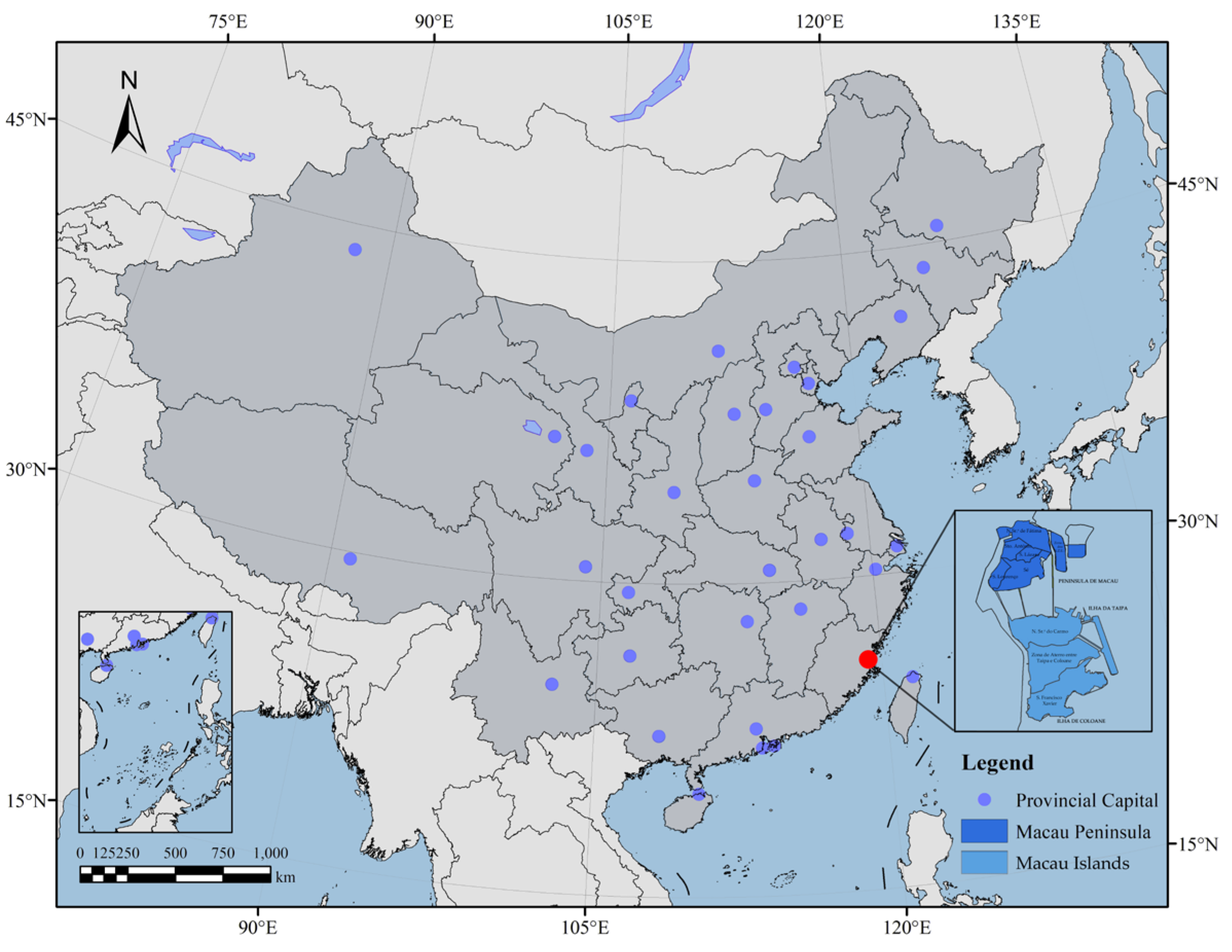
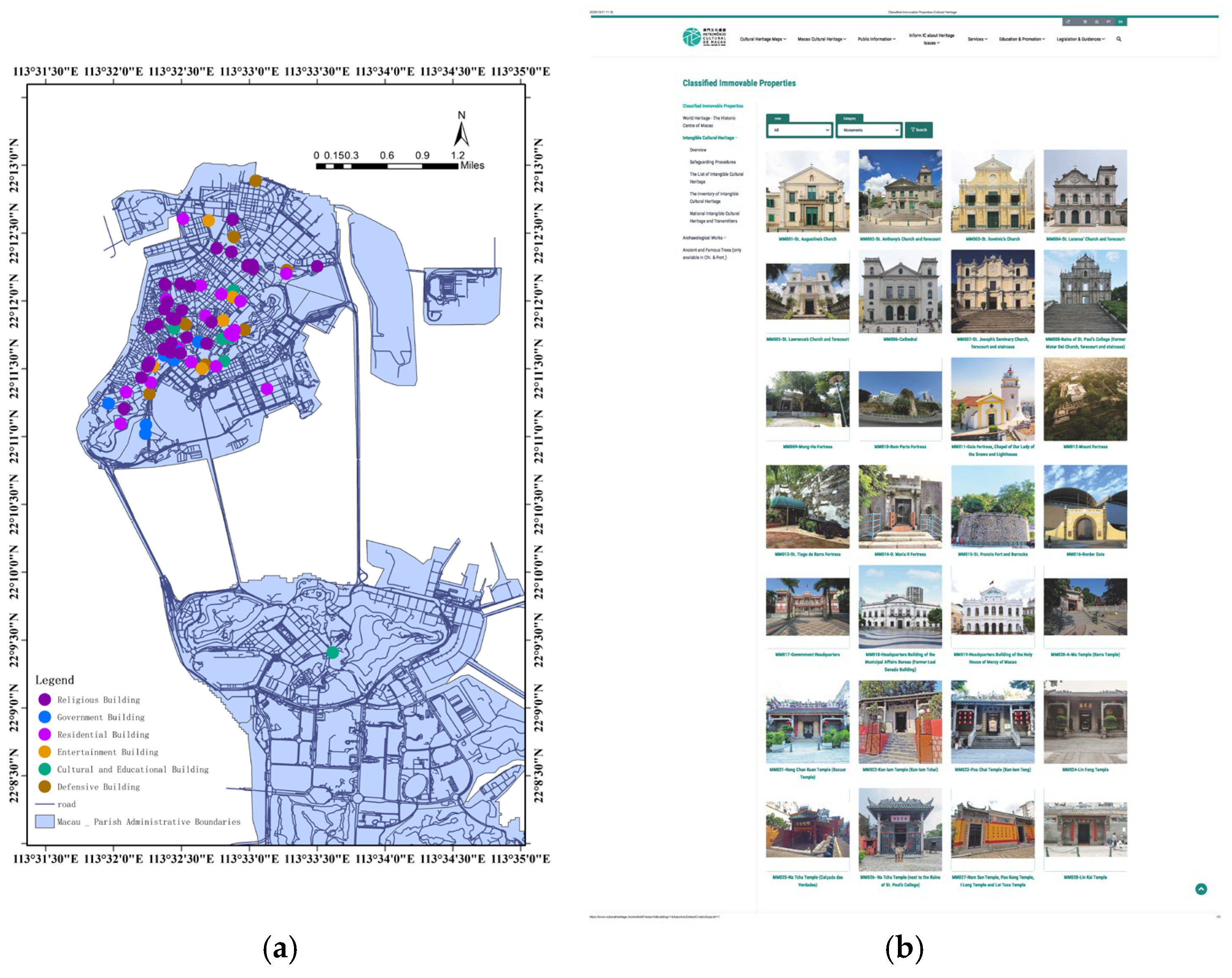

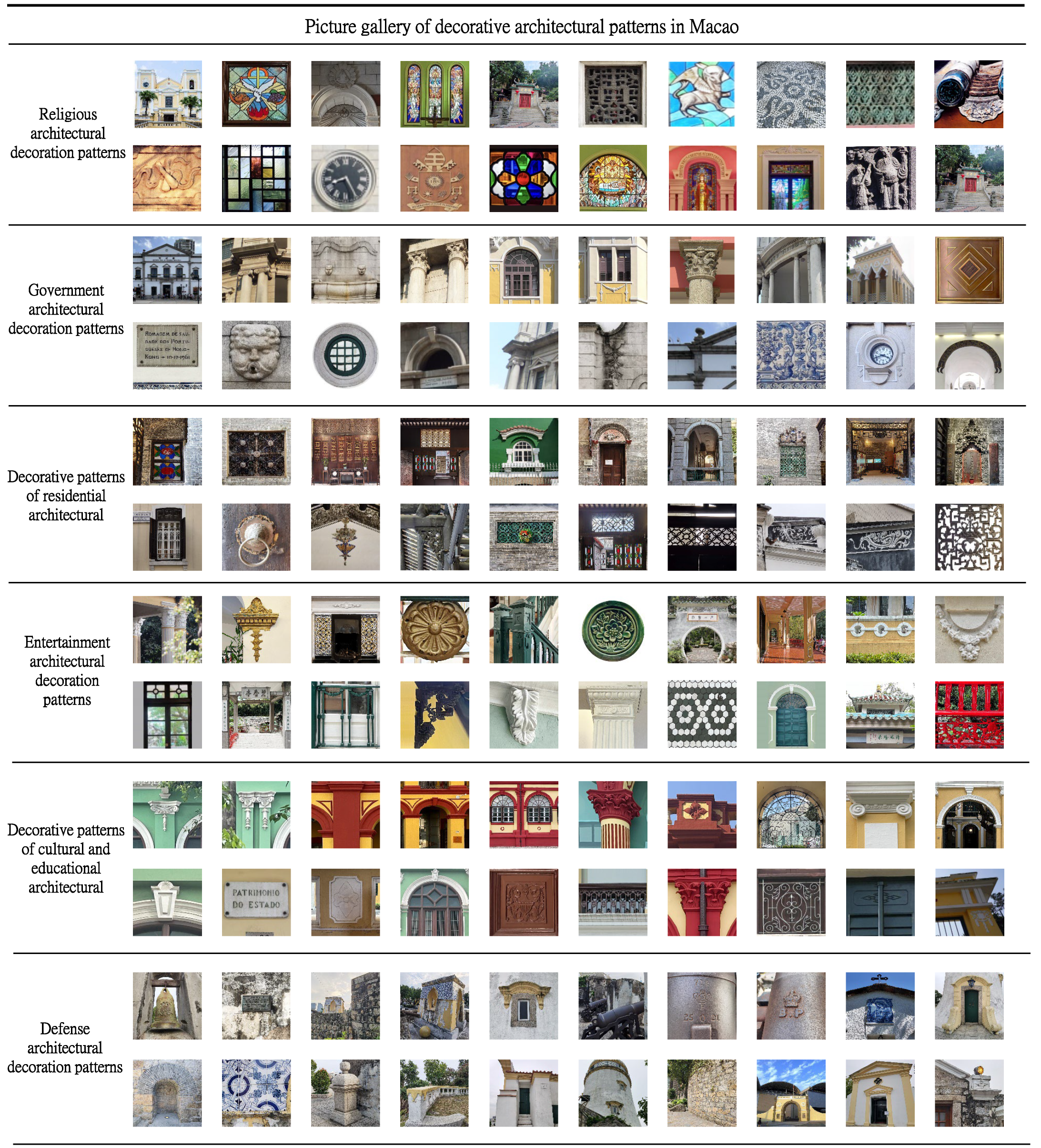
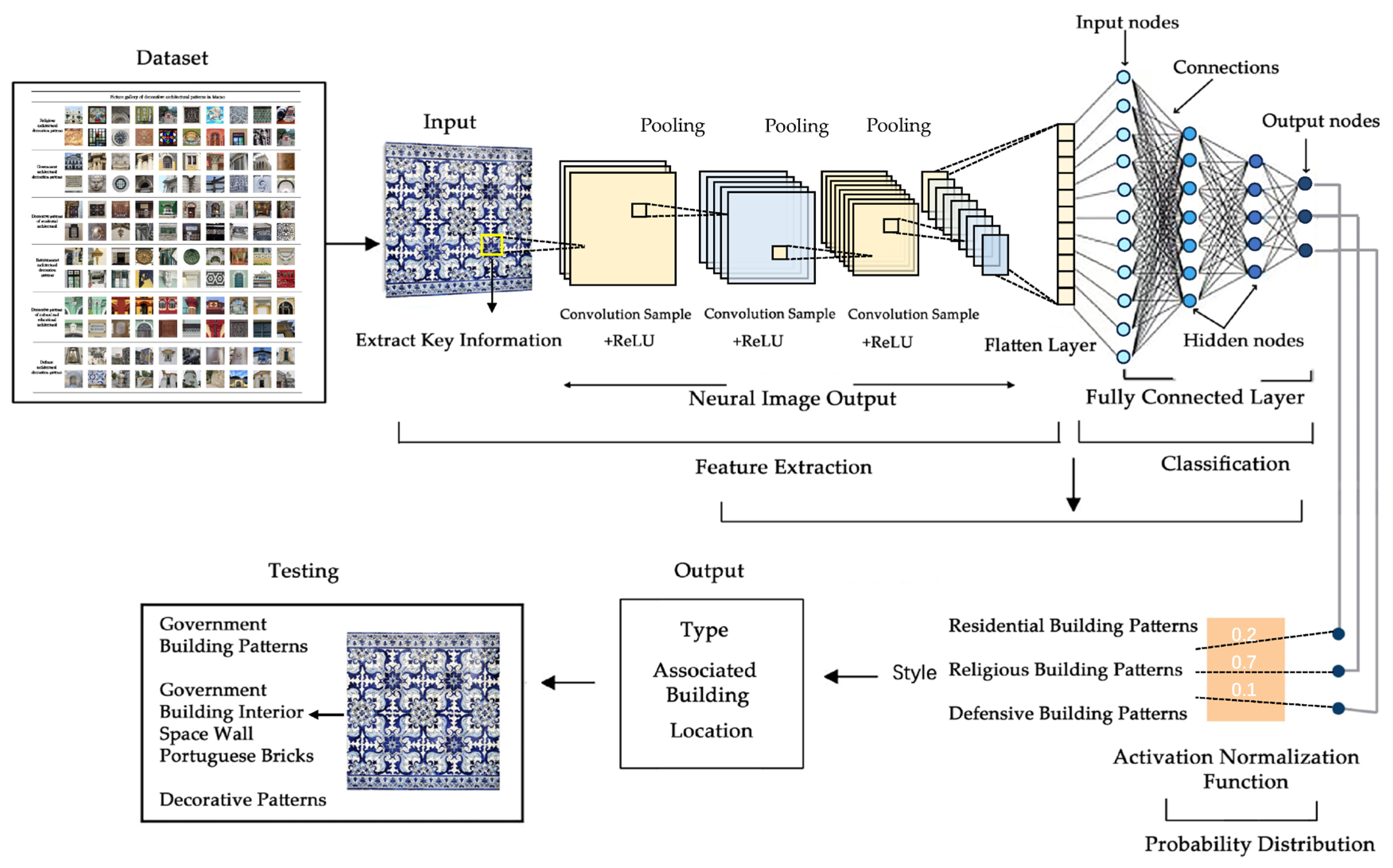
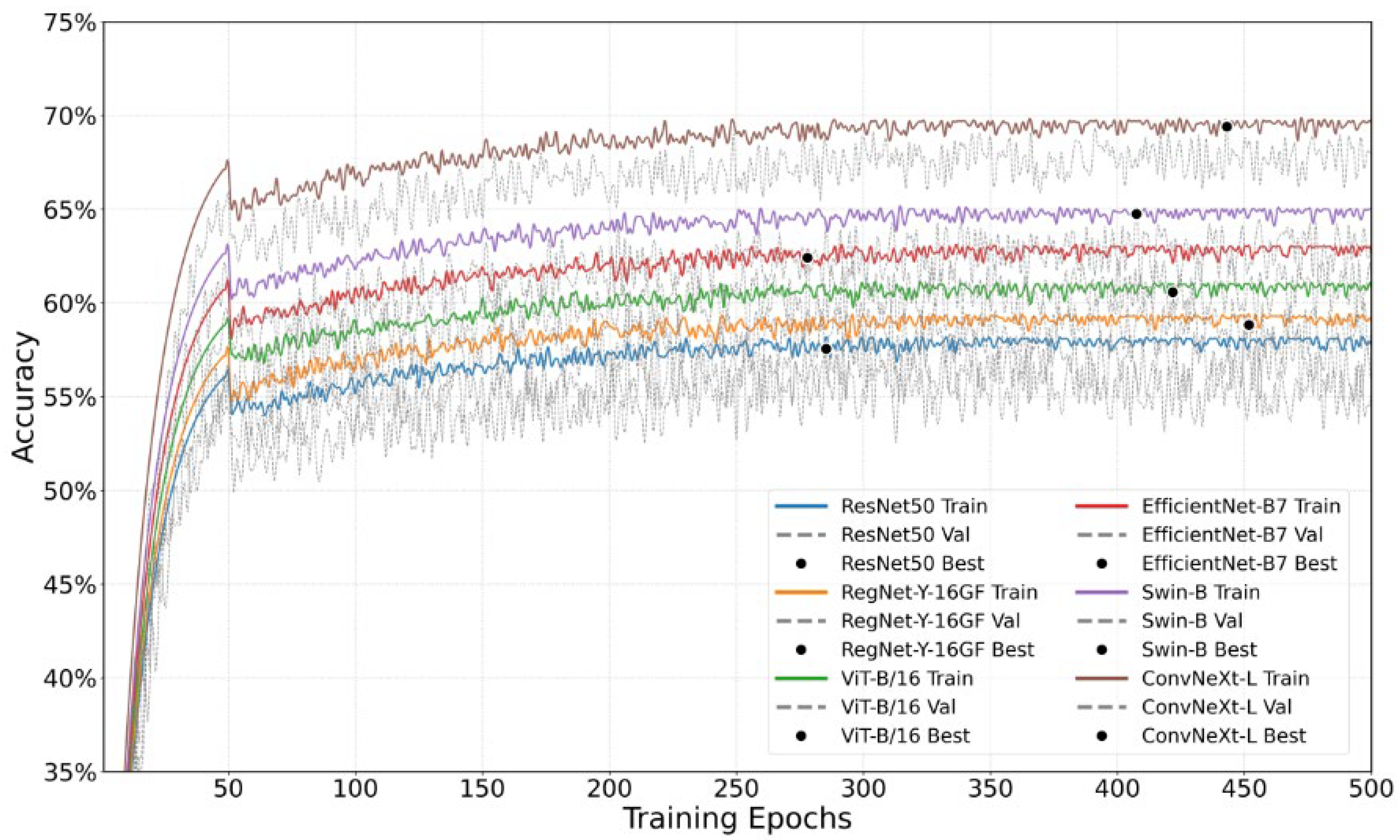

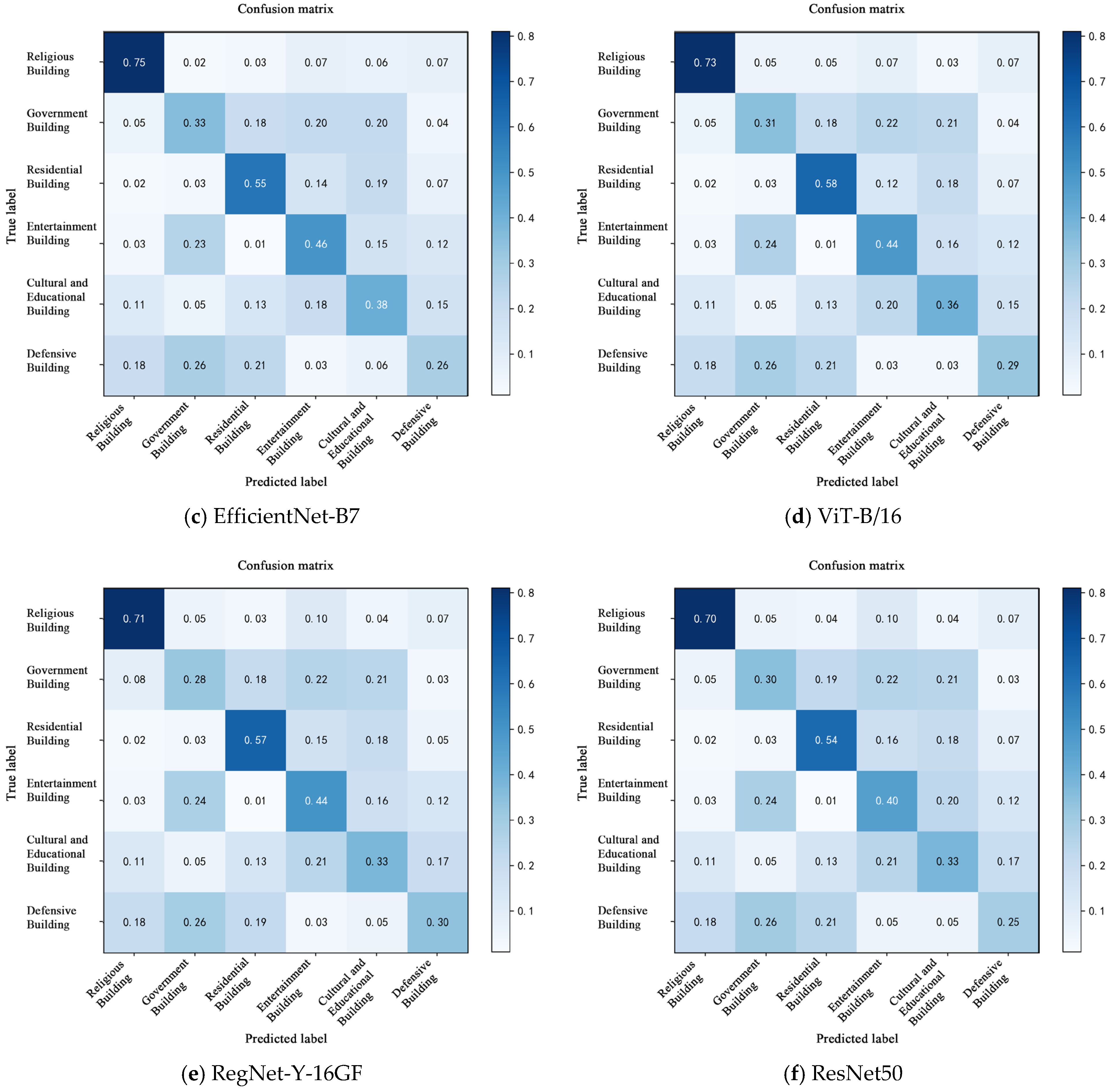
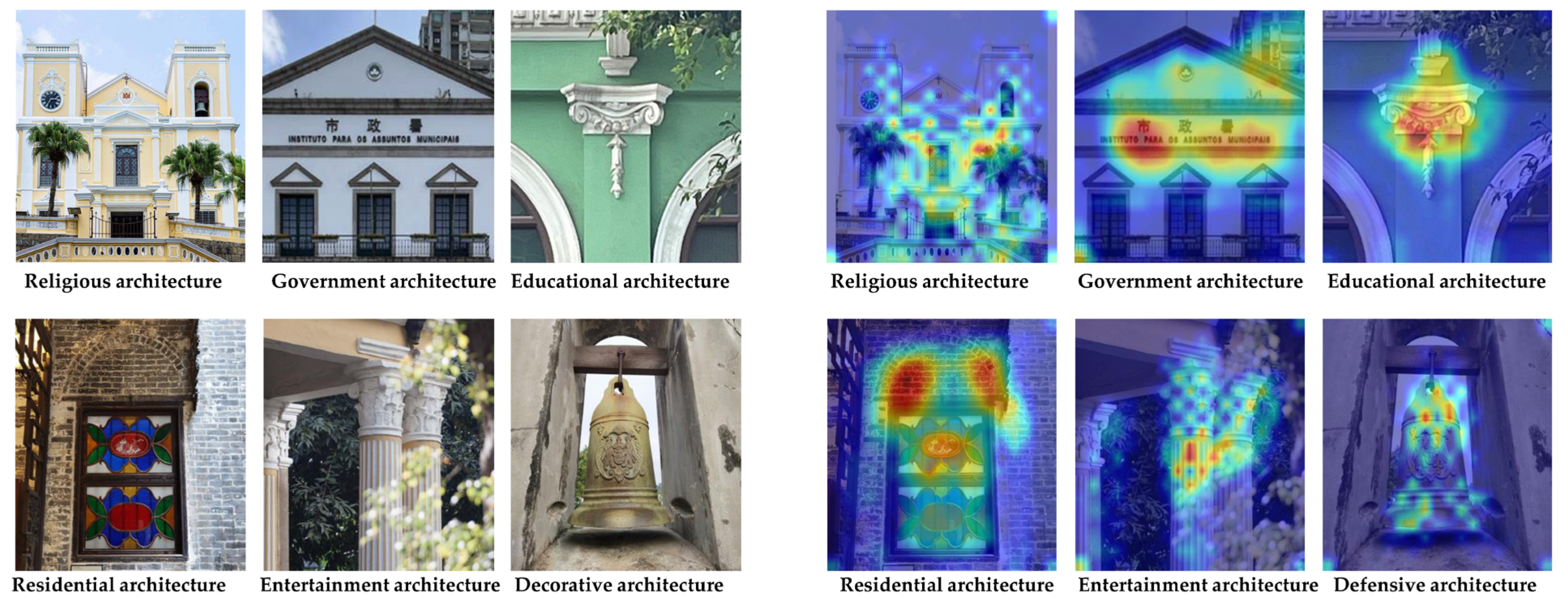
| Serial Number | Building Type | Feature Description | Number of Samples | Percentage (%) |
|---|---|---|---|---|
| 1 | Religious | Religious Stories, Symbols | 6183 | 52.37 |
| 2 | Governmental | Solemnity, Authoritative Style | 419 | 3.55 |
| 3 | Residential | Auspicious Meaning, Lifestyle | 3380 | 28.63 |
| 4 | Entertainment | Luxury or Secular Entertainment | 1600 | 13.55 |
| 5 | Cultural and Educational | Cultural and Educational Connotations | 150 | 1.27 |
| 6 | Defensive | Simplicity, Sturdiness, and Emphasis on Defense | 75 | 0.64 |
| Layer Name | Input | ConvNeXt-L | Output |
|---|---|---|---|
| conv1 | 224 × 224 × 3 | 4 × 4.96; stride4 Layer Norm | 56 × 56 × 96 |
| conv2_x | 56 × 56 × 96 | 56 × 56 × 96 | |
| conv3_x | 56 × 56 × 96 | Downsample | 28 × 28 × 192 |
| conv4_x | 28 × 28 × 192 | Downsample | 14 × 14 × 384 |
| conv5_x | 14 × 14 × 384 | Downsample | 7 × 7 × 768 |
| Classifier | 7 × 7 × 768 | Global Avg PoolingLayer NormalizationLinear | 6 classes |
| Number | Category | Precision | Recall | F1-Score | Training Set Ratio |
|---|---|---|---|---|---|
| 1 | Religious Building | 81.0% | 81% | 0.736 | 52.37% |
| 2 | Government Building | 35.16% | 32% | 0.335 | 3.55% |
| 3 | Residential Building | 57.89% | 57% | 0.538 | 28.63% |
| 4 | Entertainment Building | 52.60% | 49% | 0.456 | 13.55% |
| 5 | Cultural and Educational Building | 37.63% | 35% | 0.363 | 1.27% |
| 6 | Defensive Building | 33.13% | 27% | 0.320 | 0.64% |
| 7 | Weighted Average | 66.32% | 64.11% | 0.624 | 100% |
| Model | Accuracy (%) | Macro Average Precision (%) | Macro Average Recall (%) |
|---|---|---|---|
| ConvNeXt-L | 69.7 ± 0.7 * | 49.57 ± 0.6 * | 46.83 ± 0.8 * |
| Swin-B | 65.0 ± 1.1 | 48.3 ± 0.5 | 46.73 ± 2.0 |
| EfficientNet-B7 | 63.0 ± 1.8 | 47.2 ± 1.3 | 44.26 ± 1.9 |
| ViT-B/16 | 61.0 ± 2.5 | 46.3 ± 2.1 | 41.39 ± 1.4 |
| RegNet-Y-16GF | 59.3 ± 1.9 | 45.0 ± 1.1 | 41.3 ± 1.5 |
| ResNet50 | 58.1 ± 2.3 | 44.2 ± 1.5 | 40.3 ± 2.1 |
| Original Image and Visualized Feature Heat Map of Six Types of Historical Building Decoration Patterns |
|---|
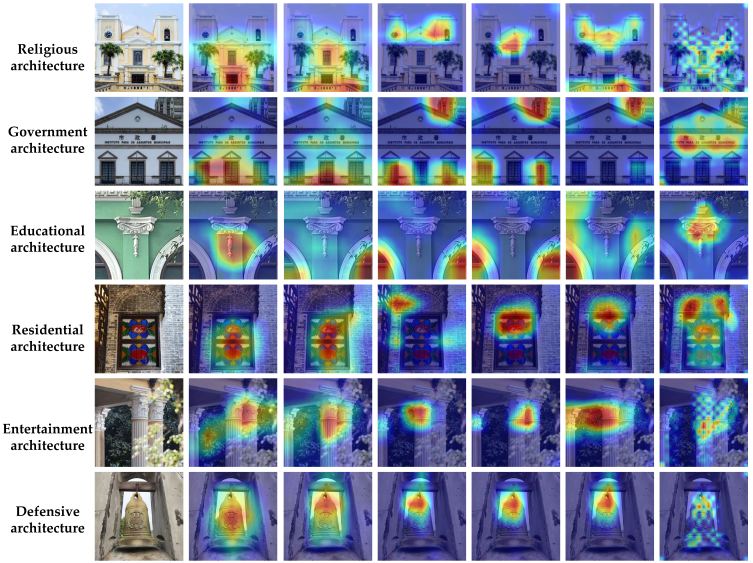 |
| Sample ResNet50 RegNet-Y-16GF ViT-B/16 EfficientNet-B7 Swin-B ConvNeXt-L |
| Building Type | ResNet50 | RegNet-Y-16GF | ViT-B/16 | EfficientNet-B7 | Swin-B | ConvNeXt-L (This Study) |
|---|---|---|---|---|---|---|
| Religious | 65.2 | 62.8 | 80.5 | 71.6 | 73.2 | 86.2 |
| Government | 60.4 | 58.1 | 72.3 | 70.5 | 71.1 | 81.7 |
| Cultural and Educational | 61.5 | 60.3 | 69.1 | 68.8 | 70.4 | 72.6 |
| Residential | 59.8 | 55.4 | 65.2 | 66.1 | 68.5 | 75.4 |
| Entertainment | 58.7 | 57.2 | 67.9 | 69.3 | 71.4 | 76.1 |
| Defensive | 55.1 | 54.9 | 63.5 | 62.8 | 64.3 | 73.5 |
| Overall Mean | 60.2 | 58.1 | 69.8 | 68.2 | 69.8 | 77.6 |
Disclaimer/Publisher’s Note: The statements, opinions and data contained in all publications are solely those of the individual author(s) and contributor(s) and not of MDPI and/or the editor(s). MDPI and/or the editor(s) disclaim responsibility for any injury to people or property resulting from any ideas, methods, instructions or products referred to in the content. |
© 2025 by the authors. Licensee MDPI, Basel, Switzerland. This article is an open access article distributed under the terms and conditions of the Creative Commons Attribution (CC BY) license (https://creativecommons.org/licenses/by/4.0/).
Share and Cite
Zhou, J.; Xie, L.; Fricker, P.; Liu, K. ConvNeXt-L-Based Recognition of Decorative Patterns in Historical Architecture: A Case Study of Macau. Buildings 2025, 15, 3705. https://doi.org/10.3390/buildings15203705
Zhou J, Xie L, Fricker P, Liu K. ConvNeXt-L-Based Recognition of Decorative Patterns in Historical Architecture: A Case Study of Macau. Buildings. 2025; 15(20):3705. https://doi.org/10.3390/buildings15203705
Chicago/Turabian StyleZhou, Junling, Lingfeng Xie, Pia Fricker, and Kuan Liu. 2025. "ConvNeXt-L-Based Recognition of Decorative Patterns in Historical Architecture: A Case Study of Macau" Buildings 15, no. 20: 3705. https://doi.org/10.3390/buildings15203705
APA StyleZhou, J., Xie, L., Fricker, P., & Liu, K. (2025). ConvNeXt-L-Based Recognition of Decorative Patterns in Historical Architecture: A Case Study of Macau. Buildings, 15(20), 3705. https://doi.org/10.3390/buildings15203705






